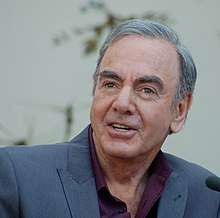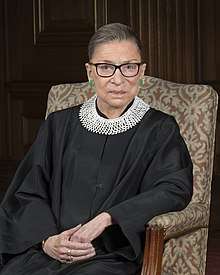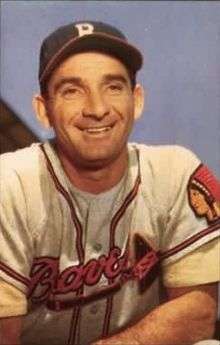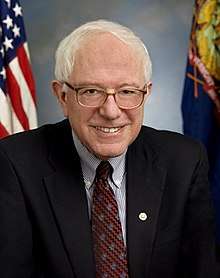Flatbush, Brooklyn
Flatbush is a neighborhood in the New York City borough of Brooklyn. Founded in 1651 by Dutch colonists, the neighborhood, which consists of several subsections, had a population of 105,804 as of the 2010 United States Census.
Flatbush | |
|---|---|
Neighborhood of Brooklyn | |
Reformed Protestant Dutch Church of Flatbush, founded in 1654 | |
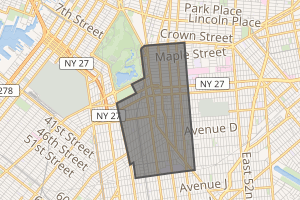
Location in New York City | |
| Coordinates: 40.645°N 73.960°W | |
| Country | |
| State | |
| City | |
| Borough | |
| Community District | Brooklyn 14[1] |
| Founded | 1651 |
| Founded by | Dutch colonists |
| Area | |
| • Total | 2.64 km2 (1.02 sq mi) |
| Population | |
| • Total | 105,804 |
| • Density | 40,000/km2 (100,000/sq mi) |
| Time zone | UTC−5 (Eastern) |
| • Summer (DST) | UTC−4 (EDT) |
| ZIP Code | 11226 |
| Area code | 718, 347, 929, and 917 |
Flatbush was a town prior to being incorporated into the City of Brooklyn, and its former border runs through the Brooklyn Botanic Garden. Generally, the township was larger than what is considered Flatbush today by the residents of Brooklyn. The modern neighborhood includes or borders several institutions of note, including Prospect Park and Brooklyn College.
Flatbush is part of Brooklyn Community District 14 and its primary ZIP Code is 11226.[1] It is patrolled by the 67th and 70th Precincts of the New York City Police Department.[3][4] Politically, Flatbush is represented by the New York City Council's 40th and 45th Districts.[5]
Etymology
The name Flatbush is a calque of the Dutch language Vlacke bos (vlacke or vlak, meaning "flat"; "Flatbush" meaning "flat woodland" or "wooded plain"),[6][7] so named from woods that grew on the flat country.[8]
History
Separate town
Flatbush was originally chartered as the Dutch Nieuw Nederland colony town of Midwout (or Midwoud or Medwoud) — from the Dutch words, med, "middle" and woud, "wood"[9] — in 1651. Both names were used in the Dutch era, and Midwood was an alternative name for Flatbush into the early 20th century. In a reversal, Midwood, now the area immediately south of Brooklyn College, is often alternatively called "Flatbush,"[10] especially among Orthodox Jews. Midwood's residents predominately feature a mix of the latter and Irish Americans.
Flatbush and the five other towns of what was to become Kings County, were surrendered to the English in 1664. The town was the county seat for Kings County and was a center of life for what is now called Brooklyn. The compact center of the village of Flatbush was at the intersection of what are now Flatbush and Church avenues, where we still find an old Dutch Reformed Church and Erasmus Hall, the oldest high school in New York City.
Flatbush played a key role in the American Revolution. Flatbush was where significant skirmishes and battles of the Battle of Long Island took place. As Kings County was settled largely by the Dutch, and as the Dutch were prominent in the slave trade, the area was somewhat sympathetic to the British side of the American Revolutionary War at the beginning of the conflict. Kings County at the time had the highest concentration of slaves north of the Mason–Dixon line – almost one-third of the total population for the county were slaves. When a Loyalist Governor of Virginia supported freedom for slaves who supported and fought on the British side, landowners in Brooklyn were concerned that a full conflict between the Colonies and the British would result in loss of their critical source of labor.[11] Loyalist residents of Flatbush included David Mathews, Mayor of New York City, who lived at what is now the intersection of Flatbush and Parkside avenues.[12] Flatbush residents maintained their loyalist sympathies: the King's Arms, for example, appeared in the town's inn for a half-century after the conclusion of the conflict.[13]
The influence of Dutch merchant and farming families remained strong in the area until after consolidation into the City of Greater New York in 1898, after which the development of Flatbush as a suburb, and then an integral part of the larger city, proceeded apace.
Before it was incorporated into the City of Brooklyn in 1894, Flatbush described both the Town of Flatbush, incorporating a large swath of central Kings County extending east to the Queens County border, and the Village of Flatbush, formerly the heart of the current community. Many of the remaining early Dutch structures are in the Flatlands and Marine Park neighborhoods.[14]
Incorporation into city
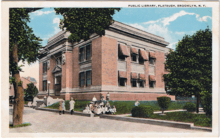
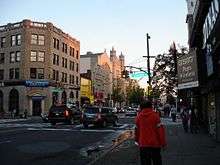
Flatbush remained relatively distant from the City of Brooklyn's denser "Gold Coast" districts (such as Brooklyn Heights, Park Slope and Fort Greene-Clinton Hill, then known collectively as The Hill) following the consolidation of New York City in 1898, but the completion of direct New York City Subway routes to Midtown Manhattan via the BMT Brighton Line and IRT Nostrand Avenue Line in 1920 connected it to surrounding areas in an unprecedented way.[14]
As six-story Art Deco apartment houses and more affordable four-story walk-up buildings were developed on Ocean Avenue and throughout its periphery,[15] Flatbush nurtured a socioeconomically diverse population of Irish Americans, Italian Americans and American Jews; according to anthropologist Ansley Hamid, occupants ranged from "merchants [and] professionals" to "skilled [and] manual laborers."[16]:128 Although the Victorian Flatbush neighborhood associations endured and grew to encompass succeeding waves of new residents, urbanization and the increasing prevalence of automobiles compelled the remaining vestiges of the neighborhood's "Anglo-Dutch elite" to "[flee] in droves for the upscale suburbs of Westchester, Long Island and New Jersey" by the late 1920s.[17]
A significant portion of Flatbush residents closely followed the Brooklyn Dodgers, which at the time were not only the team of Brooklyn but also of Flatbush in particular. Dodgers centerfielder Duke Snider was known as "the Duke of Flatbush". By 1958, however, the Dodgers left Brooklyn, and Ebbets Field eventually was torn down. Due to shifting neighborhood boundaries, Ebbets Field would today be considered to be in neighboring Crown Heights, as the ballpark was located just north of Empire Boulevard.
During the 1970s and early 1980s, Flatbush experienced a shift in demographics due to white flight as it transitioned from a white ethnic enclave to a mostly Caribbean-American community; in an ethnographic interview with Hamid, Trinidadian and Tobagonian American drug supplier and longtime resident "Patron" asserted that the demographic shift accelerated in 1974: "The whites started moving to the outskirts, further across Nostrand Avenue, or towards Sheepshead Bay. A lot moved out to Long Island. And blacks [West Indians] started moving in from Crown Heights, where buildings were being abandoned. A lot of West Indians bought up property, and then in the late 1970s, they too would start moving to Long Island, or to the nicer houses going towards Coney Island Avenue."[16]:129 By now a working class milieu (according to "Patron," large apartment buildings gradually shed doormen, porters and other conveniences following the 1975 New York City fiscal crisis),[16]:129 a handful of affluent areas remained. Prospect Park South continued to attract a sizable number of more affluent homeowners, while doctors still resided and practiced on a stretch of Parkside Avenue immediately adjacent to Prospect Park. By the mid-1980s, however, the neighborhood had numerous abandoned or semi-abandoned buildings, many of which had fallen into a state of disrepair. While crime generally had long been prevalent in the community, it worsened significantly during the 1970s, '80s and '90s.[18] A number of stores on Flatbush and Church Avenues fell victim to looting during the 1977 blackout,[19] and a subsequent drug epidemic ravaged Flatbush during the 1980s and early 1990s.[20] In February 2016, Flatbush was one of four neighborhoods featured in an article in The New York Times about "New York’s Next Hot Neighborhoods".[21] After the Vision Zero initiative was implemented across the city, WNYC found the NYPD targeting this neighborhood 36 percent more than other whiter neighborhoods like Williamsburg and Greenpoint.[22]
Demographics
Based on data from the 2010 United States Census, the population of Flatbush was 105,804, a decrease of 5,071 (4.6%) from the 110,875 counted in 2000. Covering an area of 1,038.56 acres (420.29 ha), the neighborhood had a population density of 101.9 inhabitants per acre (65,200/sq mi; 25,200/km2).[2]
The racial makeup of the neighborhood was 19.9% (21,030) White, 48.6% (51,470) African American, 0.3% (281) Native American, 9.2% (9,712) Asian, 0.0% (26) Pacific Islander, 0.5% (575) from other races, and 1.9% (2,051) from two or more races. Hispanic or Latino of any race were 19.5% (20,659) of the population.[23]
The entirety of Community Board 14, which comprises Flatbush and Midwood, had 165,543 inhabitants as of NYC Health's 2018 Community Health Profile, with an average life expectancy of 82.4 years.[24]:2, 20 This is slightly higher than the median life expectancy of 81.2 for all New York City neighborhoods.[25]:53 (PDF p. 84)[26] Most inhabitants are middle-aged adults and youth: 25% are between the ages of 0–17, 29% between 25–44, and 24% between 45–64. The ratio of college-aged and elderly residents was lower, at 9% and 13% respectively.[24]:2
As of 2016, the median household income in Community Board 14 was $56,599.[27] In 2018, an estimated 22% of Flatbush and Midwood residents lived in poverty, compared to 21% in all of Brooklyn and 20% in all of New York City. One in eleven residents (9%) were unemployed, compared to 9% in the rest of both Brooklyn and New York City. Rent burden, or the percentage of residents who have difficulty paying their rent, is 57% in Flatbush and Midwood, higher than the citywide and boroughwide rates of 52% and 51% respectively.
Culture
While Flatbush is predominantly African American and West Indian, there are sizable numbers of Caucasians, Latinos and Indian Americans living within its borders. A majority of residents are working class, but there also are middle-class and wealthier residents who call Flatbush home. The primary commercial strips are Flatbush, Church, and Coney Island Avenues. One can find Caribbean food, Soul food, Chinese, Mexican and South Asian restaurants. Most of the businesses are small, with some larger businesses also present. A large part of the culture in Flatbush is the use of "dollar vans". These "vans" are actually minibuses that provide a cheaper alternative to riding the MTA. Residents pay $2 to travel along Flatbush Avenue from Kings Plaza to Tillary St. While many dollar vans operate illegally, they are still a major part of transportion in Flatbush.
Flatbush housing varies in character. It generally features apartment buildings, though some rowhouses also are present. Older, Victorian-style housing can be found in Prospect Park South, and brownstones are in Prospect Lefferts Gardens.
The Flatbush community has been receiving an influx of immigrants from the Caribbean, mostly from Guyana, Haiti, Trinidad and Tobago, Jamaica, Grenada, Barbados, Saint Lucia, Saint Vincent and the Grenadines, Dominica, Antigua and Barbuda, Saint Kitts and Nevis and Belize, since the 1980s, as well as immigrants from South Asia, primarily India, Pakistan and Bangladesh and African countries like Ghana, Zimbabwe, Nigeria, and Kenya. Haitians are the largest ethnic group in Flatbush. Prior to the arrival of these groups, the Flatbush community had already been diverse, with many Italian-Americans, Irish-Americans, African-Americans and Jewish-Americans.
Subsections and geographic boundaries
The former town of Flatbush coincided roughly with Brooklyn Community District 14, which runs north-south from Prospect Park to Kings Highway. The boundaries of the neighborhood today are not precisely defined, but much of the areas below have typically been considered part of the community. The portion of Flatbush that is not part of any other community is roughly bounded by Clarkson Avenue to the north, New York Avenue to the east, Long Island Rail Road's Bay Ridge Branch to the south, and Ocean Avenue to the west.
The neighborhoods of Flatbush extend south from the old Brooklyn City Line north of the southern edges of Prospect Park, the Brooklyn Botanic Garden and Empire Boulevard. The southern border of Flatbush neighborhoods is approximately on the line of the Bay Ridge Branch, which runs to the south of Avenue H, the campus of Brooklyn College, and "The Junction" where Flatbush and Nostrand Avenues intersect. Flatbush's eastern border is roughly around New York Avenue, while its western border is Coney Island Avenue.
Neighborhoods within Flatbush include the planned communities of Prospect Park South, the Beverley Squares (Beverley Square East and Beverley Square West), Prospect Lefferts Gardens, Ditmas Park, Fiske Terrace, Victorian Flatbush, and Albemarle-Kenmore Terrace. Bordering Flatbush on the north are the community of Crown Heights and the former neighborhood of Pigtown. On the east, within the old town of Flatbush, is East Flatbush, on the west are Kensington and Parkville (formerly Greenfield), and on the south is Midwood. Midwood, also part of Community District 14, was historically part of the neighboring former towns of New Utrecht, Gravesend and Flatlands. Flatbush includes the southernmost portion of Prospect Park.
Notable institutions
Well-known institutions within Flatbush include Erasmus Hall High School, the Parade Ground, the Flatbush Dutch Reformed Church, and Brooklyn College. The neighborhood also contained Ebbets Field, the last Brooklyn home of the Brooklyn Dodgers baseball team before it was demolished in 1960; however, due to imprecise boundaries, the Ebbets Field site may also be considered to be in Crown Heights. The Kings Theatre, listed on the National Register of Historic Places, operated from 1929 to 1977;[28] it reopened as a live show venue in February 2015 after extensive renovations.[29]
Community organizations
The bustling business district and neighborhoods of Flatbush are supported by several important community organizations. The Flatbush Avenue Business Improvement District provides services to keep Flatbush Avenue from Parkside Avenue to Cortelyou Road clean, safe and profitable for its businesses. Every year, the Flatbush BID organizes the Flatbush Avenue Street Fair,[30] an event that celebrates the cultures of the community. The Flatbush Development Corporation (FDC) is a nonprofit that hosts events and programs that are aimed to support the "vitality, diversity and quality of life" in the Flatbush community. CAMBA, Inc. is a Flatbush-based nonprofit that since 1977 has provided housing, youth education and development, legal services and healthcare services to residents of Flatbush and beyond.
Police and crime
Flatbush is patrolled by two precincts of the NYPD.[31] The 70th Precinct is located at 154 Lawrence Avenue and serves Ditmas Park, Prospect Park South, and Midwood,[4][32] while the 67th Precinct is located at 2820 Snyder Avenue and serves East Flatbush.[3][33] The 70th Precinct ranked 30th safest out of 69 patrol areas for per-capita crime in 2010,[32] while the 67th Precinct ranked 40th safest.[33] With a non-fatal assault rate of 42 per 100,000 people, Flatbush and Midwood's rate of violent crimes per capita is less than that of the city as a whole. The incarceration rate of 372 per 100,000 people is lower than that of the city as a whole.[24]:8
The 70th Precinct has a lower crime rate than in the 1990s, with crimes across all categories having decreased by 89.1% between 1990 and 2018. The precinct reported 6 murders, 27 rapes, 162 robberies, 273 felony assaults, 173 burglaries, 527 grand larcenies, and 75 grand larcenies auto in 2018.[34] The 67th Precinct also has a lower crime rate than in the 1990s, with crimes across all categories having decreased by 79.9% between 1990 and 2018. The precinct reported 6 murders, 43 rapes, 246 robberies, 601 felony assaults, 225 burglaries, 586 grand larcenies, and 98 grand larcenies auto in 2018.[35]
Fire safety
Flatbush is served by three New York City Fire Department (FDNY) fire stations:[36]
Health
Preterm births are more common in Flatbush and Midwood than in other places citywide, though teenage births are less common. In Flatbush and Midwood, there were 99 preterm births per 1,000 live births (compared to 87 per 1,000 citywide), and 17.1 teenage births per 1,000 live births (compared to 19.3 per 1,000 citywide).[24]:11 Flatbush and Midwood has a relatively high population of residents who are uninsured, or who receive healthcare through Medicaid.[40] In 2018, this population of uninsured residents was estimated to be 16%, which is higher than the citywide rate of 12%.[24]:14
The concentration of fine particulate matter, the deadliest type of air pollutant, in Flatbush and Midwood is 0.0077 milligrams per cubic metre (7.7×10−9 oz/cu ft), lower than the citywide and boroughwide averages.[24]:9 Ten percent of Flatbush and Midwood residents are smokers, which is slightly lower than the city average of 14% of residents being smokers.[24]:13 In Flatbush and Midwood, 28% of residents are obese, 13% are diabetic, and 31% have high blood pressure—compared to the citywide averages of 24%, 11%, and 28% respectively.[24]:16 In addition, 21% of children are obese, compared to the citywide average of 20%.[24]:12
Eighty percent of residents eat some fruits and vegetables every day, which is lower than the city's average of 87%. In 2018, 77% of residents described their health as "good," "very good," or "excellent," slightly less than the city's average of 78%.[24]:13 For every supermarket in Flatbush and Midwood, there are 21 bodegas.[24]:10
Hospitals in Flatbush include Kings County Hospital and SUNY Downstate Medical Center.[40]
Post offices and ZIP Codes
Flatbush is covered by ZIP Codes 11203, 11210, 11225, and 11226. 11226 is the primary ZIP Code for Flatbush.[41]
The United States Post Office branches in Flatbush are the Flatbush Station at 2273 Church Avenue,[42] the Newkirk Station at 1525 Newkirk Avenue,[43] and the Vanderveer Station at 2319 Nostrand Avenue.[44]
Education
Flatbush and Midwood generally has a similar ratio of college-educated residents to the rest of the city. Though 43% of residents age 25 and older have a college education or higher, 18% have less than a high school education and 39% are high school graduates or have some college education. By contrast, 40% of Brooklynites and 38% of city residents have a college education or higher.[24]:6 The percentage of Flatbush and Midwood students excelling in math rose from 43 percent in 2000 to 68 percent in 2011, though reading achievement remained steady at 48% during the same time period.[45]
Flatbush and Midwood's rate of elementary school student absenteeism is about equal to the rest of New York City. In Flatbush and Midwood, 18% of elementary school students missed twenty or more days per school year, compared to the citywide average of 20% of students.[25]:24 (PDF p. 55)[24]:6 Additionally, 75% of high school students in Flatbush and Midwood graduate on time, equal to the citywide average of 75% of students.[24]:6
Schools
Flatbush is home to a number of elementary and intermediate schools, as well as the Erasmus Hall High School campus. Founded in 1786, it has a long list of famous alumni. Its building has been expanded numerous times, and is notable for its relatively unique architecture. Since 1994, the building has been divided internally into five smaller high schools, each concentrating on a different academic area.
Brooklyn College (one of the four-year colleges in the City University of New York system) occupies a 35-acre (14 ha) campus shared between the neighborhoods of Flatbush and Midwood.[46]
Several Jewish yeshivas are in the neighborhood, including the Mir Yeshiva, Yeshiva Rabbi Chaim Berlin, Yeshiva Torah Vodaas, Yeshiva Torah Temimah, Yeshiva Tiferes Yisroel, and the Yeshivah of Flatbush. Combined, they form a major center of Jewish learning.[47][48][49] The area had an estimated total enrollment of 14,500 students in 2004.[50]
Libraries
The Brooklyn Public Library (BPL) has three branches in Flatbush. The Flatbush branch is located at 22 Linden Boulevard east of Flatbush Avenue. It was built in 1905 as a Carnegie library branch.[51] The Clarendon branch is located at 2035 Nostrand Avenue south of Farragut Road. It was founded as a deposit station with a small circulating collection in 1913. The branch moved into its current building in 1954, and it was renovated in 1990.[52] The Crown Heights branch, located on the border with Crown Heights, is located at 560 New York Avenue near Maple Street.[53]
Transportation
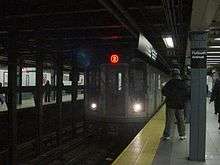
Flatbush is well served by public transportation. On the New York City Subway, the BMT Brighton Line (B and Q trains) has a number of stops within the community. The stretch of stations from Prospect Park to Avenue H is in Flatbush. Though just outside the neighborhood's boundaries, the IRT Nostrand Avenue Line (2 and 5 trains) also serves Flatbush from Sterling Street to the terminal Flatbush Avenue–Brooklyn College station.[54]
The B6, B7, B8, B12, B16, B35, B41, B44 and B49 are MTA Regional Bus Operations routes that serve the neighborhood; some of them also have limited-stop variants, and the B44 also have Select Bus Service variants. In addition, the B103, a wholly limited-stop bus, runs through Flatbush, while the Q35 runs entirely on a limited-stop basis in Brooklyn, connecting Flatbush with the Rockaways.[55]
The major roadways through Flatbush include Flatbush Avenue, Nostrand Avenue and Ocean Avenue, which are North-South corridors, and Linden Boulevard, Church Avenue and Caton Avenue, which are East-West corridors.
In popular culture
- Flatbush is mentioned in The Lords of Flatbush, a 1974 film set in 1958.[56]
- The area is also mentioned in an eponymous 1979 sitcom.
- According to Mel Blanc, the character's original voice actor, Bugs Bunny has a Flatbush accent.
- The Mario Brothers from the Mario video game franchise, Mario and Luigi, are said to be from Flatbush. In the animated TV series The Super Mario Bros. Super Show!, as well as the Super Mario Bros. Hollywood movie, Mario and Luigi's business, "Mario Brothers Plumbing Services", is operated out of Flatbush.
- Philip J. Fry, from the TV series Futurama, is originally from Flatbush.
- Flatbush is one of the principal locations featured in William Styron's novel Sophie's Choice. The protagonist, Stingo, takes up residence there in 1947. He befriends Sophie and Nathan, and soon learns of Sophie's tortured history.
- Claudius Lyon, the parody of the fictional detective Nero Wolfe created by Loren Estleman, lives in a brownstone in Flatbush as part of his efforts to mimic Wolfe's lifestyle.
- The Flatbush Zombies, a popular hip-hop trio, is named after Flatbush, where the trio grew up.
- In The Incredible Mr. Limpet (1964), Bessie (Carole Cook) tells her husband Henry (Don Knotts) that, "...if you paid half as much attention to me as you do those fish I'd be the happiest wife in Flatbush."
Notable residents
Notable residents of Flatbush have included:
- Michael Badalucco (born 1954), actor[57]
- Joseph Barbera (1911-2006), animator[58]
- John Boardman, professor emeritus of physics, Brooklyn College; science fiction fan, author and fanzine publisher; and gaming authority.
- Dane Clark (1912-1998), actor[59]
- Roz Chast (born 1954), cartoonist for The New Yorker[60]
- Al Davis (1929-2011), owner and general manager of the Oakland Raiders[61]
- Neil Diamond (born 1941), singer[62]
- David Draiman (born 1973), vocalist for Disturbed.[63]
- Da Bush Babees
- Cella Dwellas
- East Flatbush Project
- Richard Fariña (1937-1966), folksinger, novelist and poet [64]
- Patrick Fitzgerald (born 1960), attorney.[65]
- Fu-Schnickens
- Full Force
- Flatbush Zombies
- Ruth Bader Ginsburg (born 1933), United States Supreme Court Justice.[66]
- Sidney "Sid" Gordon (1917–1975), Major League Baseball All-Star player.
- Sonia Greene (1883-1972), pulp fiction writer and amateur publisher.
- Susan Hayward (1917-1975), actress.[67]
- Leona Helmsley (1920-2007), businesswoman who was known for her flamboyant personality and her reputation for tyrannical behavior.[68]
- Hurricane G, rapper.
- Jidenna (born 1985), rapper.
- Joey Badass (born 1995), rapper, singer, songwriter, record producer and actor.
- JPEGMafia (born 1989), rapper and record producer.[69]
- Eric Kaplan (born 1971), television writer and producer.[70]
- Alvin Klein (c. 1938–2009), theater critic for The New York Times[71]
- Talib Kweli (born 1975), rapper, entrepreneur and activist.[72]
- Jackie Loughery (born 1930), actress and beauty pageant titleholder who was crowned Miss USA 1952.[73]
- Norman Mailer (1923-2007), novelist.
- David Mathews
- Jimmy McMillan (born 1946), political activist and perennial candidate.
- Joe Paterno (1926-2012), football coach.
- JTG
- Rampage
- Red Cafe
- Busta Rhymes
- Chubb Rock
- Rowdy Rebel
- Dmitry Salita
- Bernie Sanders[74]
- Shaggy
- Mimi Sheraton
- Bobby Shmurda
- Special Ed
- Richard Sheirer[75]
- Michael Showalter
- Shyne
- Peter Steele
- Capital Steez
- Barbra Streisand
- Bruce Sudano
- Paul Sylbert (1928-2016), production designer, art director and set designer.[76]
- The Underachievers
- Don Vultaggio, billionaire co-founder of Arizona Beverage Company[77]
- Devin Wenig[78]
- Michael K. Williams[79]
- Angela Yee
References
- "NYC Planning | Community Profiles". communityprofiles.planning.nyc.gov. New York City Department of City Planning. Retrieved April 7, 2018.
- Table PL-P5 NTA: Total Population and Persons Per Acre - New York City Neighborhood Tabulation Areas*, 2010, Population Division - New York City Department of City Planning, February 2012. Accessed June 16, 2016.
- "NYPD – 67th Precinct". www.nyc.gov. New York City Police Department. Retrieved October 3, 2016.
- "NYPD – 70th Precinct". www.nyc.gov. New York City Police Department. Retrieved October 3, 2016.
- Current City Council Districts for Kings County, New York City. Accessed May 5, 2017.
- "Flatbush Malls". NYC Dept. of Parks & Recreation. December 12, 2001. Retrieved May 29, 2009.
- "Lefferts Historic House". Prospect Park Alliance. Archived from the original on September 24, 2008. Retrieved May 29, 2009.
- Gannett, Henry (1905). The Origin of Certain Place Names in the United States. Govt. Print. Off. pp. 126.
- Chisholm, Hugh, ed. (1911). . Encyclopædia Britannica. 10 (11th ed.). Cambridge University Press. p. 482.
- Matus, Irvin Leigh (2000). "When the Dream Was Made". Urbanography. Archived from the original on April 27, 2009. Retrieved September 3, 2013.
[On the Vitagraph Studio lot in Brooklyn, located adjacent to the Brighton railroad, in what is now Midwood, called South Greenfield at the time]: William Shea, among the first actors in the Big V's stock company, recalled the Brighton's role after filming began in 1905: After the building of the Flatbush studio, interior scenes were taken at the Nassau Street address and exterior scenes at Flatbush. In a picture that had both interior and exterior scenes it was a case of collecting all necessary wardrobe and props and moving to Flatbush. It must have been a sight to see fifteen or twenty people get off a train, some carrying bundles and boxes with a sword or spear sticking out, a little bit of a fellow struggling along with a suit of armor, and various other bulky properties distributed among members of the party, but it was part of the game. Very few of the actors kicked and the populace became used to seeing us doing all kinds of stunts.
- The Ordeal of Kings County by Edwin G. Burrows as part of Tiedemann and Fingerhut (editors) The Other New York: The American Revolution Beyond New York City 2005
- Vanderbilt, Gertrude Lefferts The Social History of Flatbush, and Manners and Customs of the Dutch Settlers of Kings County D. Appleton & Company, 1881
- "New York city guide; a comprehensive guide to the five boroughs of the metropolis: Manhattan, Brooklyn, the Bronx, Queens, and Richmond". archive.org. Retrieved December 6, 2015.
- Federal Writers' Project (1939). "New York City Guide". New York: Random House. pp. 492–495. ISBN 978-1-60354-055-1. (Reprinted by Scholarly Press, 1976; often referred to as WPA Guide to New York City.)
- Allbray, N.C. (2004). Flatbush: The Heart of Brooklyn. Making of America series. Arcadia Pub. p. 124. ISBN 978-0-7385-2453-5. Retrieved June 21, 2020.
- Hamid, A. (2002). The Ganja Complex: Rastafari and Marijuana. Lexington Books. ISBN 978-0-7391-0360-9. Retrieved June 21, 2020.
- Campanella, T. (2020). Brooklyn: The Once and Future City. Princeton University Press. pp. 71–72. ISBN 978-0-691-20861-9. Retrieved June 21, 2020.
- "If You're Thinking of Living in Flatbush". New York Times. January 30, 1983. Retrieved February 3, 2017.
- "Looters prey on the city during the blackout of 1977". NY Daily News. July 12, 2015. Retrieved February 3, 2017.
- Rohde, David (August 17, 1997). "Where Has Your Neighborhood Drug Dealer Gone?". The New York Times. Retrieved February 3, 2017.
- Higgins, Michelle (February 26, 2016) "New York’s Next Hot Neighborhoods" The New York Times
- Flatbush Activists Want to Know Where the NYPD is Stopping Brooklyn Drivers | Ditmas Park, NY Patch
- Table PL-P3A NTA: Total Population by Mutually Exclusive Race and Hispanic Origin - New York City Neighborhood Tabulation Areas*, 2010, Population Division - New York City Department of City Planning, March 29, 2011. Accessed June 14, 2016.
- "Flatbush and Midwood (Including Ditmas Park, Flatbush, Manhattan Terrace, Midwood, Ocean Parkway and Prospect Park South)" (PDF). nyc.gov. NYC Health. 2018. Retrieved March 2, 2019.
- "2016-2018 Community Health Assessment and Community Health Improvement Plan: Take Care New York 2020" (PDF). nyc.gov. New York City Department of Health and Mental Hygiene. 2016. Retrieved September 8, 2017.
- "New Yorkers are living longer, happier and healthier lives". New York Post. June 4, 2017. Retrieved March 1, 2019.
- "NYC-Brooklyn Community District 14--Flatbush & Midwood PUMA, NY". Census Reporter. Retrieved July 17, 2018.
- Gray, Christopher. "The Kings Is Dead! Long Live the Kings!", The New York Times Accessed March 11, 2007
- The Neighborhood News, New York magazine, February 4, 2013, p. 10
- "Flatbush Avenue Street Fair". Flatbush Avenue BID. July 7, 2016. Retrieved February 3, 2017.
- "Find Your Precinct and Sector - NYPD". www.nyc.gov. Retrieved March 3, 2019.
- "Midwood, Ditmas Park & Prospect Park South – DNAinfo.com Crime and Safety Report". www.dnainfo.com. Archived from the original on April 15, 2017. Retrieved October 6, 2016.
- "East Flatbush – DNAinfo.com Crime and Safety Report". www.dnainfo.com. Archived from the original on March 6, 2019. Retrieved October 6, 2016.
- "70th Precinct CompStat Report" (PDF). www.nyc.gov. New York City Police Department. Retrieved July 22, 2018.
- "67th Precinct CompStat Report" (PDF). Retrieved July 22, 2018.
- "FDNY Firehouse Listing – Location of Firehouses and companies". NYC Open Data; Socrata. New York City Fire Department. September 10, 2018. Retrieved March 14, 2019.
- "Engine Company 255/Ladder Company 157". FDNYtrucks.com. Retrieved March 2, 2019.
- "Engine Company 281/Ladder Company 147". FDNYtrucks.com. Retrieved March 2, 2019.
- "Engine Company 248/Battalion 41". FDNYtrucks.com. Retrieved March 2, 2019.
- New York City Health Provider Partnership Brooklyn Community Needs Assessment: Final Report, New York Academy of Medicine (October 3, 2014).
- "NYC Neighborhood ZIP Code Definitions". New York State Department of Health. November 7, 2014. Retrieved March 5, 2019.
- "USPS Locations". Retrieved June 20, 2018.
- "USPS Locations". Retrieved June 20, 2018.
- "PO Locator | USPS". tools.usps.com. Retrieved February 17, 2020.
- "Flatbush / Midwood – BK 14" (PDF). Furman Center for Real Estate and Urban Policy. 2011. Retrieved October 5, 2016.
- Maps and Directions, Brooklyn College. Accessed October 25, 2016. "Brooklyn College is located on a 35-acre campus in the Midwood / Flatbush neighborhoods. The college is easily accessible by car and public transportation."
- Moshe D. Sherman (1996). Orthodox Judaism in America: A Biographical Dictionary and Sourcebook. ISBN 9780313243165.
- Ilana Abramovitch, ed.; Seán Galvin, ed. (2001). Jews of Brooklyn. New York City: Brandeis University Press. ISBN 978-1-58465-003-4.CS1 maint: multiple names: authors list (link) CS1 maint: extra text: authors list (link)
- Jack Wertheimer, ed (2007). Imagining the American Jewish Community. New York City: Brandeis University Press.CS1 maint: extra text: authors list (link)
- "Where do NYC Jewish Kids Go To School" (PDF). Retrieved January 1, 2018.
- "Flatbush Library". Brooklyn Public Library. August 22, 2011. Retrieved February 21, 2019.
- "Clarendon Library". Brooklyn Public Library. August 19, 2011. Retrieved February 21, 2019.
- "Crown Heights Library". Brooklyn Public Library. August 19, 2011. Retrieved February 21, 2019.
- "Subway Map" (PDF). Metropolitan Transportation Authority. October 21, 2019. Retrieved January 18, 2018.
- "Brooklyn Bus Map" (PDF). Metropolitan Transportation Authority. November 2017. Retrieved April 24, 2018.
- Ferrara, Greg. "The Lords of Flatbush". Turner Classic Movies. Retrieved February 3, 2017.
- Cahill, Gloria. "Michael Badalucco", Radiance magazine, Fall 1998. Accessed November 28, 2016. "Badalucco grew up in the working-class neighborhood of Flatbush, Brooklyn."
- Itzkoff, Dave. "Joseph Barbera, Half of Cartoon Duo, Dies at 95", The New York Times, December 19, 2006. Accessed November 28, 2016. "Born Joseph Roland Barbera on March 24, 1911, in the Little Italy section of Manhattan and raised in Flatbush, Brooklyn, Mr. Barbera tried his hand at banking, playwriting and amateur boxing before the successful sale of a sketch to Collier's magazine encouraged him to pursue a career as a cartoon artist."
- Bartnett, Edmond J. "Kid From Flatbush; Or How Dane Clark Went From the Prize Ring to Movies in a Few Easy Steps", The New York Times, May 26, 1946. Accessed October 19, 2019. "A Giant rooter born in Flatbush, a former boxer, baseball player, highway laborer, soda jerk, sculptor's model and lawyer, to say nothing of a movie star--that sounds like a lot of different people."
- Leland, John. "Roz Chast Is New Yorkier Than You", The New York Times, October 11, 2017. Accessed October 19, 2019. "Ms. Chast in person is exactly what you’d expect from her cartoons: a little neurotic, a lot New Yorky, openly phobic, smallish, with chunky glasses and a Brooklyn accent that could probably be traced to a single census tract in Flatbush.... Ms. Chast grew up in the Flatbush section of Brooklyn, the only child of parents who rarely left the neighborhood."
- O'Connor, Ian. "Root for Raiders, but don't pull for Davis", USA Today, January 25, 2003. Accessed November 28, 2016. "Davis grew up in Flatbush and saw Walter O'Malley forever steal a piece of Brooklyn's soul, yet he had no problem running the Raiders out of Oakland and hitting a resistant league in court for $49.2 million in damages."
- Egan, Barry. "Neil Diamond: I've waited 70 years for happiness", Belfast Telegraph, November 11, 2014. Accessed November 28, 2016. "Neil Diamond - whom I've an appointment to see - grew up in vaguely impoverished circumstances above a shop (not Harrods, a butcher's shop) in Flatbush, Brooklyn, where he would be woken up in the night to the sound of the mousetraps going off."
- Ewing, Jerry. "Disturbed’s David Draiman: My Life Story", Metal Hammer, August 9, 2016. Accessed October 19, 2019. "Where and when were you born? 'I was born on March 13, 1973. It was in a hospital in Flatbush, which is a suburb of Brooklyn in New York.'"
- Hajdu, David. Positively Fourth Street. p. 39. "In truth, Fariña was born and raised in a pleasant Irish Catolic pocket of Flatbush, Brooklyn."
- Stephey, M. J. "Patrick Fitzgerald", Time (magazine), December 11, 2008. Accessed October 19, 2019. "Born to Irish immigrants in the Flatbush neighborhood of Brooklyn."
- Wolfe, Jonathan. "Today’s New York News: Honoring Ruth Bader Ginsburg", The New York Times, September 27, 2018. Accessed October 19, 2019. "Justice Ginsburg grew up in Flatbush, Brooklyn, during the Depression."
- Thompson, Howard. "Flatbush To Kilimanjaro And Back", The New York Times, April 20, 1952. Accessed October 19, 2019. "Miss Hayward was a native of Brooklyn? 'Flatbush,' came the husky reply, in two distinct syllables."
- Saulny, Susan. "Leona Helmsley on the Stand: The Moment They Waited For", The New York Times, January 29, 2003. Accessed October 19, 2019. "Mrs. Helmsley was asked simple biographical questions that highlighted her roots in Flatbush, Brooklyn."
- Michael, Michael Love. "JPEGMAFIA Is Doing It All Wrong", Paper (magazine), September 13, 2019. Accessed October 19, 2019. "When JPEGMAFIA, the rapper known to fans and friends as Peggy, hops on the phone, he quickly admits he's got the munchies. The fluid conversation that follows speaks to how he, an Iraq War veteran raised in Flatbush, Brooklyn before moving to Alabama then Louisiana, is more thoughtful shape-shifter than mindless stoner."
- Dreifus, Claudia. "A Conversation With: On The Big Bang Theory, Helping Physics and Fiction Collide", The New York Times, September 10, 2013. Accessed October 19, 2019. "[Q] You grew up in Brooklyn, right? [A] I grew up in Flatbush. My mother was a biology teacher at Erasmus Hall. My father was a storefront lawyer."
- Staff. "Alvin Klein, Times Theater Reviewer, Dies at 73", The New York Times, March 6, 2009. Accessed June 7, 2016. "The son of immigrants from Poland, Mr. Klein was born in Brownsville, Brooklyn, and grew up in Flatbush."
- Christian, Tanya A. "Talib Kweli Kicked Off Valentine’s Weekend With A Love Note To Brooklyn", Essence (magazine), February 17, 2019. Accessed October 19, 2019. "'I was the only African-American on my block in Flatbush. That’s a real story,' Kweli joked about his upbringing in Kings County."
- "Beauty From Flatbush Now Rides The Range". Sarasota Herald-Tribune. November 11, 1955.
- Horowitz, Jason (July 24, 2015). "Bernie Sanders's '100% Brooklyn' Roots Are as Unshakable as His Accent" – via NYTimes.com.
- Weber, Bruce (January 19, 2012). "Richard J. Sheirer, Official in Charge of Sept. 11 Rescues, Dies at 65". The New York Times. Retrieved February 4, 2012.
- Grimes, William. "Paul Sylbert, Oscar-Winner Who Gave Movies Their Look, Dies at 88", The New York Times, November 25, 2016. Accessed November 29, 2016. "Paul Sylbert was born on April 16, 1928, in Brooklyn, and grew up in the Flatbush neighborhood.... After graduating from Erasmus Hall High School in 1946, he served in the same Army unit in Korea as his brother."
- Peterson-Withorn, Chase (October 17, 2017). "Inside Arizona Iced Tea: How Don Vultaggio Beat Snapple, Became A Billionaire And Nearly Lost It All". Forbes. Retrieved October 14, 2018.
- "Where is Devin Wenig now?". Crains. Retrieved November 4, 2014.
- "Magic Mike: Michael K. Williams's Disappearing Act". September 1, 2012.
External links
| Wikimedia Commons has media related to Flatbush, Brooklyn. |

- Early history of Flatbush, pre-1842 Accessed 2008-11-17
